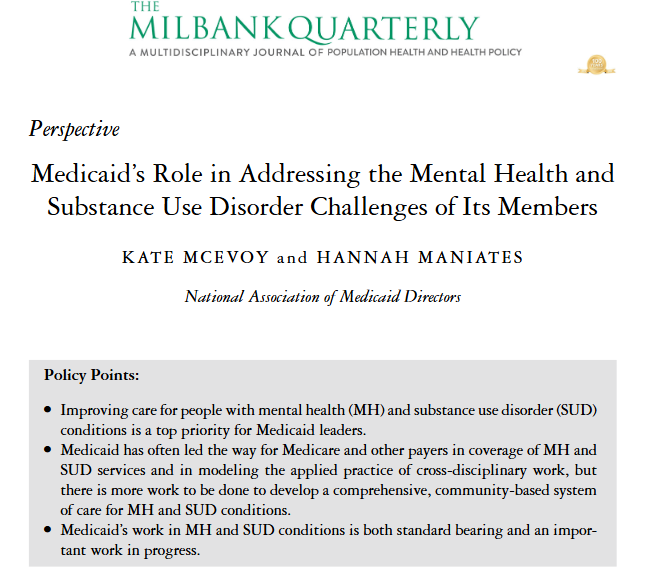Published Findings: How Medicaid Addresses Member Mental Health and Substance Use Disorder Challenges
Author
- Kate McEvoy and Hannah Maniates

Please read an excerpt from Kate McEvoy and Hannah Maniates’ article in the peer-reviewed publication, The Milbank Quarterly.
Medicaid, which, since its inception in 1965, has reflected a federal-state/territory partnership model, has both greatly advanced the scope and integration of mental health (MH) and substance use disorder (SUD) services among payers and remains a work in progress with respect to scaling and funding these services across the country. In this perspective, we posit that this constructive tension arises out of four key factors. First, because there is no federally mandated, uniform Medicaid MH and SUD benefit, there remains significant variability in how MH and SUD benefits are implemented across states and territories. Second, states and territories continue to face significant challenges associated with budget constraints, workforce shortages, and historical artifacts associated with siloing of health and human services. However, third, Medicaid’s capacity to innovate is enabled by a permissive array of federal law authorities and periodic availability of federal demonstration funds that have allowed state and territory programs to tailor service array and delivery models to fit their needs as well as to experiment with new approaches. Fourth, states and territories have more extensive interests than do private insurers and Medicare in covering MH and SUD services because they 1) typically serve Medicaid members over longer intervals than do private plans, 2) need to optimize use of limited state general funds, 3) want to address voter priorities, and 4) have direct influence over policy levers in both health and human services. Across the country, Medicaid programs have therefore centered on improving the integration and coordination of health care and social services across systems, including supports for children with complex health needs, coordination of transitions and connection to community-based health care for people leaving justice settings, and addressing the housing needs of people with MH conditions and SUD. In recognition of all of the factors noted above, our discussion:
- highlights Medicaid programs’ role in addressing MH and SUD;
- outlines the drivers and challenges associated with variability of coverage among programs;
- capsules three examples of innovative cross-systems work; and
- points to areas in need of further attention, investment, and research.
There is a dynamic tension between Medicaid’s influence among payers in scope and innovation in provision of MH and SUD and the challenges it continues to face in underwriting the costs of services, achieving more consistency among programs nationwide, and integrating those services with means of addressing the human services needs of its members.
Medicaid programs across the United States are a foundational source of coverage for people with MH conditions and SUD. As the largest payer for MH and SUD services, Medicaid demonstrably serves as the central seat of access to treatment and recovery supports. However, because many MH and SUD services in Medicaid are characterized as optional under federal law, MH and SUD benefits in Medicaid reflect a patchwork quilt of authority pathways and coverage parameters. This variability in covered services and service accessibility arises out of factors such as historical reliance on institutional settings as opposed to community-based alternatives, siloing in the structure of state administration of and associated challenges in braiding health and human services funding (e.g., housing assistance), and differences in state budget capacity and competing priorities for limited state general funds.
Recognizing this, many Medicaid programs are focused on filling gaps by expanding coverage of MH and SUD services and by addressing access issues. This includes “rebalancing” services from a historically institutional model to a more community-based recovery model as well as building new service arrays, such as crisis response services. Medicaid agencies are also focused on improving access to covered services by partnering with their sister agency workforce boards to address workforce shortages, using telehealth, and building in coverage of extenders (e.g., peer support professionals).
Notwithstanding budgetary constraints and variability of the Medicaid MH and SUD benefit across the country, however, Medicaid also often originates and creates an evidence base around innovations in MH and SUD services, acting as a model for other payers in its scope, breadth, parity, and integration of services. Many of these innovations have focused on coordinating and integrating physical health, MH, and social services through applied partnerships among Medicaid programs and their human services and corrections department peers. We posit that Medicaid’s capacity for cross- system innovation arises out of state and territory strong fiscal and political incentives to improve health and social outcomes for individuals with MH conditions and SUD, as well as companion interest in optimizing the use of limited state general funds.
Related resources
Medicaid Meets Public Health: A Blueprint for Collaboration
NAMD Comments on Office of National Drug Control Policy’s (ONDCP) 2026 Strategy
Stay Informed
Drop us your email and we’ll keep you up-to-date on Medicaid issues.